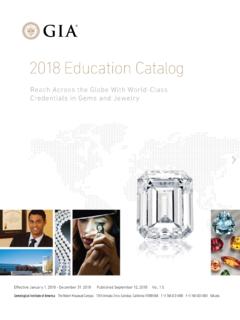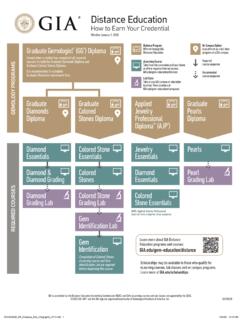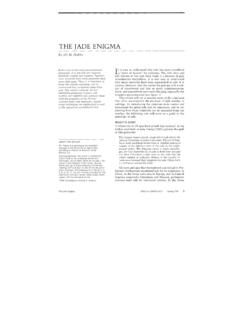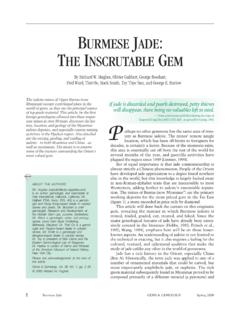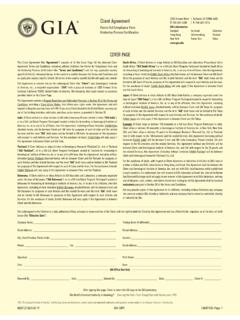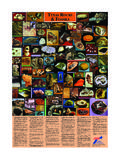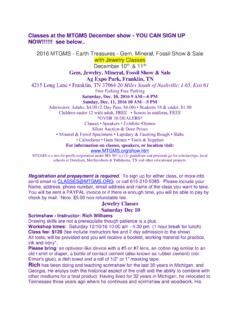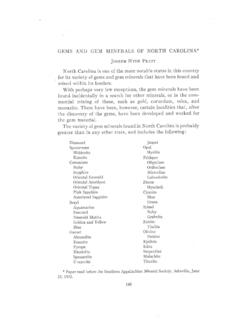Transcription of Spring 2002 Gems & Gemology - GIA
1 The Ultimate Gemologist: A Tribute to Richard T. LiddicoatDona M. Dirlam, James E. Shigley, and Stuart D. OverlinEDITORIALREGULARFEATURESpg. 32 FEATUREARTICLES80 Color grade vs. value for fancy-color diamonds Diamond with eclogitic inclusions Diamond with a large void Genthelvite: A second occurrence Jadeite carving: Assembled, dyed, and impregnated Coated natural pearls Spinel in heat-treated sapphireGem Trade Lab Notes111 Book Reviews107 The Dr. Edward J. G belin Most Valuable Article Award1092002 Gems & GemologyChallenge114 Gemological Abstracts86 Special report:New corundum treatment from Thailand Tucson 2002:Symposia Amethyst and fluorite from Afghanistan Stingray coral Canadian emeralds Andesine feldspar from Congo Fluorite from the Rogerleymine, England Demantoid garnet from Iran Kyanite from Nepal Pargasitefrom China Ruby from northern Kenya Black spinel from Mexico Nigerianelbaite with Cu Vesuvianite from Kenya and Madagascar Star opal triplets Plus:Emeralds from Hiddenite, North Carolina Star emerald from Madagascar Tourmaline slider in quartzGem News Internationalpg.
2 22pg. 86 VOLUME 38, NO. 1 Spring 2002 NOTES ANDNEWTECHNIQUESA look at the extraordinary career of Richard T. Liddicoat: Celebrating 50 Years of LeadershipWilliam E. Boyajian1 Portable Instruments and Tips on Practical Gemology in the FieldEdward W. Boehm14An essential guide to the use of portable instruments when purchasing Tourmaline from Anjanabonoina, MadagascarDona M. Dirlam, Brendan M. Laurs, Federico Pezzotta, and William B. (Skip) Simmons28 Explores the world s primary source of this remarkable calcium-rich lithiumtourmaline, named in honor of Richard T. of the South: A Historic 128 ct DiamondChristopher P. Smith and George Bosshart54A history and characterization of this famous of Yellow Cultured Pearls from the Black-Lipped Oyster Pinctada MargaritiferaShane Elen66 How absorption features can establish the origin of these cultured from Sri LankaKarl Schmetzer, George Bosshart, Heinz-J rgen Bernhardt, Edward J. G belin, andChristopher P.
3 Smith73A characterization of this rare gem material from Sri does one encounter an individual whoalters the course of history. It is even morerare to know a person of such stature, or to havethe chance to work under his or her have been privileged to work for, and alongside,Richard T. Liddicoat throughout my nearly 27 yearsat GIA. I have seen him, in goodtimes and bad, endure challengesand tribulations, and never fal-ter. I know him to be a man ofextreme intelligence, impeccablecharacter, and genuine is a unique combination ofwarmth and charm, drive anddedication. This issue of Gems & Gemologyhonors Richard Liddicoat s 50years as chief editor of the jour-nal. Each paper represents a dif-ferent aspect of his contributionto Gemology . The lead article, byDona Dirlam and others, gives us a glimpse into hislife, his passion, and his accomplishments in anindustry he loves and for the public he serves.
4 Inhonor of his leadership in the field of Gemology ,researchers at the Smithsonian Institution bestowedthe name liddicoatiteon a new gem tourmalinespecies in 1977. The article on liddicoatite in thisissue contributes greatly to our understanding of thisbeautiful but enigmatic gem. Throughout his career, Richard Liddicoat has focusedon gem identification and instruments to make thisprocess easier and more efficient, sharing knowledgethat greatly influenced the development of the con-temporary field instruments and techniques dis-cussed in Edward Boehm s piece. But he is also fasci-nated with the lore of fabulous stones , like the Star ofthe South diamond described by Christopher Smithand George Bosshart, that have contributed so muchto the rich history of our issue rounds off with short articles on two top-ics of particular interest to Richard Liddicoat pearlsand new gem materials. Although a mineralogist bytraining, he has long had a fondness for organicmaterials and especially the intricacies of pearlssuch as the Tahitian yellow cultured pearlsdescribed by Shane Elen.
5 I wonder, though, if there isa greater thrill for any gemologist than the opportu-nity to examine a new gem material, as with theserendibites characterized by Dr. Karl Schmetzer andMr. Liddicoat s colleague for more than 60 years, G belin, along withother prominent gemologists. I suppose it would be enough tohave established diamond grad-ing and other standards for thegem and jewelry trade, to haveeducated countless thousands inthe field, or to have contributedmightily to the gemological lit-erature over the course of hislong and successful career. Butperhaps the greatest gift RichardLiddicoat has given us is theexample he set for an industryand its professionals. Not onlyis he a beloved and respected leader, but he also haslived out a work ethic and a commitment to pur-pose that are both rare and resounding. As we look back over the years, and his achieve-ments, we recognize that they are unparalleled: agem mineral named after him; awards and honorsfrom GIA, the American Gem Society, the AmericanGem Trade Association, and numerous other organi-zations; and a lasting impact on thousands whorevere him as the Father of Modern Gemology .
6 Yet one of Richard Liddicoat s most appealing qual-ities is that he has never realized how great he trulyis. This issue of Gems & Gemologyis a tribute tohis character and to what makes him, in my mindand in the minds of all who know him, a man whohas altered the course of history in the gem andjewelry world. William E. Boyajian, PresidentGemological Institute of AmericaEDITORIALGEMS&GEMOLOGYSPRING20021 RRICHARDT. LIDDICOAT:CELEBRATING50 YEARS OFLEADERSHIPTHEULTIMATEGEMOLOGIST:A TRIBUTE TORICHARDT. LIDDICOAT2 RICHARDT. LIDDICOATGEMS& GEMOLOGYSPRING2002dence. At the time, no such organization existed inthe In the early 1930s, Shipley working inpartnership with his wife Beatrice stimulatedinterest among jewelers by traveling across the retail stores, where he would preach the benefitsof gemological education. In the evenings in hishotel room, Shipley would write courses for jewel-ers to take through correspondence.
7 He establishedthe beginnings of an educational institute in LosAngeles with a small staff that grew slowly over thenext decade as resources allowed. Together, he andhis staff created lessons, gave instruction on gem- stones and their properties, and began the process ofhelping jewelers correctly identify the gem materi-als they handled (Gilbert, 1977).By 1940, Shipley realized the need for additionalleadership at GIA. His son, Robert Shipley Jr., whohad worked closely with him in recent years, hadsigned up for military service. Shipley contactedChester B. Slawson, a mineralogy professor at theUniversity of michigan in Ann Arbor who was By Dona M. Dirlam, James E. Shigley, and Stuart D. OverlinSee end of article for About the Authors and Gemology , Vol. 38, No. 1, pp. 2 13. 2002 Gemological Institute of AmericaOn this occasion the celebration of Richard T. Liddicoat s 50 years guiding Gems & Gemology it is fitting to review his enormous impact on the field of Gemology .
8 This includes the developmentof GIA s education program, the creation of the quality-grading system for polished diamonds thatis now accepted worldwide, numerous contributions to the gemological literature, involvement innew gem-testing techniques and instruments, and the establishment of a formal research greatest achievement, however, has been his personal influence on the professionalism andethical standards of the international gem and jewelry this special issue of Gems & Gemology , we celebrate the 50th anni-versary of Richard T. Liddicoat (figure 1)as editor and now editor-in-chief of GIA s quarterlyprofessional journal. This festschrift, or special cele-bratory issue, provides a welcome opportunity toreview his contributions to Gemology , especially infive main areas: education, diamond quality grad-ing, gem identification, instrument development,and global information outreach. Following the leadof GIA s founder, Robert M.
9 Shipley, Liddicoat posi-tioned GIA as a leading international educationalinstitution, grading laboratory, manufacturer of geminstruments, and research center. Those who havehad the privilege to know and work with him havebeen able to expand the frontiers of Gemology bystanding on the shoulders of this giant. THE EARLY YEARSR obert M. Shipley founded the GemologicalInstitute of America in Los Angeles, California, in1931. His vision was to create an institution thatwould promote professional education in gemologyfor jewelers in the United States, allowing them tobuy and sell with increased knowledge and confi-W If I have seen farther .. it is by standing on the shoulders of giants. Isaac Newtonco-author of one of the leading Gemology texts atthat time, Gems and Gem Materials(Kraus andSlawson, 1939), as well as one of GIA s educationaladvisors. In his letter, Shipley asked Slawson to rec-ommend a mineralogist to join the GIA faculty.
10 Suggested one of his graduate students,Richard T. Liddicoat. As Liddicoat recalled, Slawson thought that I was wedded to graduateschool and headed for a in mineralogy, so hedidn t think I d be interested. But he showed the let-ter to me anyway. After years of school, I was readyto do something else. The idea of gems and LosAngeles really had appeal (Youngs, 1980, p. 40). Liddicoat drove with his wife Mary Imogene( Gene ) Liddicoat to Cincinnati, Ohio, for aninterview with Robert Shipley and then-chairmanof GIA s Board of Governors, Edward found both men impressive, with Shipley espe-cially charismatic in his passion for education Thomas Liddicoat Jr. was born onMarch 2, 1918, in Kearsarge, michigan , the son of aprofessor of engineering at the University ofMichigan, Ann Arbor, and Carmen Beryl WilliamsLiddicoat. Both his grandfathers were miners fromCornwall, England, who had immigrated to theupper Keweenaw Peninsula of michigan in the lat-ter half of the 19th century.
